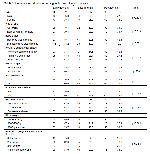In our study, approximately 21.2% of mothers were outside the 18-35 age range. As it is known, pregnancies occurring in adolescence and older age are evaluated in the category of risky pregnancies. In the study conducted by Sevilay et al. among women delivered in the hospital, the rate of those giving birth under the age of 18 was 2.5%, while the percentage of those giving birth at an older age was 14.5% and the rate of cesarean delivery, blood transfusion, placenta previa, low birth weight, and the need for intensive care was increased for adolescent pregnancies. On the other hand, the risk of gestational diabetes and preeclampsia is high in older pregnancies
7. According to the 2018 TDHS data, the teenage fertility rate was 30 per thousand in Turkiye. Adolescent pregnancies contribute to the continuation of the poverty cycle and the condition of poor health among generations, as well as maternal and child deaths
8.
In our study, while the infant mortality rate was 10.4 per thousand in 2014, this rate was 9.0 per thousand in 2017. After the Classification of Statistical Region Units 1, in which the province of Elazig is located, the infant mortality rate, which was 18.1 per thousand in the eastern Anatolia region, decreased to 9.7 per thousand in 2018. Turkiye has reduced the overall mortality from 9.3 to 13.9 per thousand in the same period 3. Although there is a downward trend worldwide, quite different rates are detected between regions. The infant mortality rate is an important indicator that negatively affects the life expectancy of a society 9. Infant mortality rates tend to decrease on a global and regional basis. This may be influenced by factors, such as increased resources devoted to health care and an increase in education levels.
Of the cases, 48.8% were babies with very low birth weight, and 20.3% of them had low birth weight. Low birth weight is considered as a crucial risk factor that increases the rate of neonatal death 10.
Of the infant mortality, 68.2% occurred in the neonatal period, 25.9% of which was observed in the late neonatal period and 42.2% in the early neonatal period, and the other 31.8% occurred in the postneonatal period. In the study done by Korkmaz et al. 6 on infant mortality across Turkiye, when the cases were evaluated based on the time of death, it was determined that 76.1% were neonatal deaths, 56.5% of which were early neonatal and 19.5% were late neonatal deaths, and 23.9% were postneonatal infant mortality. In the study conducted by Ma et al. 11, 38.5% of infant mortalities were in the early neonatal period, 18.1% in the late neonatal period, and 43.4% in the postneonatal period.
In our study, 68.9% of the deliveries were cesarean sections. In the survey conducted by Taş et al. 2 in the city of Kahramanmaras, the cesarean rate was 39.2%. The caesarean section rate is increasing rapidly in most countries, including Turkey. 14. The cesarean rate is influenced by many factors, such as education, wealth, age, and regional factors 15. According to the study of Betran et al. 16, cesarean rates tend to increase worldwide. Cesarean delivery and low birth weight rates are high among dying babies.
In 21.0% of births in our study, the time between two births is less than two years. In a similar study, the frequency of the time between two pregnancies being less than 24 months was 17.6% 12. The time between birth intervals is generally affected by the settlement, region, education, and welfare levels. In those who have less than two years between two births, the infant mortality rate is higher. Among women with high levels of welfare and education, the frequency of those with a shorter pregnancy duration of fewer than 24 months was lower 15. It can be a useful intervention to prevent mortality by training new couples about pregnancy planning.
We observed that 63.1% of pregnant women had at least four follow-up visits, and 36.9% had 3 or fewer follow-ups. In a study carried out by pregnant women in the city of Elazig by Akkus et al. 17, it was found that all pregnant women went to pregnancy controls at least once, and 74.5% had four or more pregnancy follow-ups. It is known that prenatal care services starting late in the pregnancy cause an increase in the proportions of infant mortality 10. Lack of care in the prenatal period increases the infant mortality rate 15.
In our study, prematurity, prematurity-related diseases, congenital heart diseases, and congenital anomalies were among the top causes of infant mortality. In the survey conducted by Tas et al. 12 in the city of Kahramanmaras, congenital anomaly, respiratory distress syndrome, and sepsis were in the first three ranks. In a study conducted by Kosan et al. 18, congenital defect and sepsis were the leading causes of infant mortality. To prevent infant mortality, it is imperative to provide full prenatal care services and detect anomalies early.
It was observed that the early neonatal infant mortality rate decreased with the increase in the number of pregnancy follow-ups. In the study of Wolde et al. 19, being born from a mother with no ANC visit increased neonatal death odds compared to mothers with ≥4 ANC visits. According to the study by Atkinson 20, women who faced obstacles in accessing prenatal care have been shown to have higher infant mortality rates than women facing no barriers. In the study by Annan et al. 21, it was stated that taking high-quality antenatal care would prevent a significant number of neonatal deaths. It may be beneficial to intervene by targeting factors that reduce antenatal care 22. This finding is compatible with the literature 23,24. Due to insufficient lung development resulting in hypoxia, which can result in respiratory failure and death, preterm babies cant adapt to extra-uterine life 25.
The mortality rate of low birth weight babies in the neonatal period was significantly higher compared to normal birth weight babies (p<0.001). Also, infant deaths are higher in those with low birth weight or gestational intervals of less than two years. Studies are showing that low birth weight increases the mortality rate in the neonatal period26,12.
The frequency of consanguineous marriage is significantly lower among mothers with high school or higher education levels. In a similar study conducted by Taş et al. in Kahramanmaras, the frequency of blood-related couples was 25.9% 12. It has been observed that those who have consanguineous marriages have lower education levels, lower socioeconomic statuses, earlier gestational ages, higher risk of delivering a baby with a congenital anomaly, and, although there was no significant difference, higher risk of stillbirths 27, As seen in the studies above, preventing consanguineous marriage will also prevent infant mortality and stillbirths. Thus, increasing the level of education with social supports and increasing the socioeconomic levels will benefit the creation of healthy new generations.
As a result, two-thirds of infant mortality rates occurred during the neonatal period. Prematurity and related diseases are in the first place within the causes of infant mortality. The neonatal periods mortality rate is significantly higher in babies with a low level of maternal education, breastfeeding, exposure to meconium, and low birth weight. Additionally, adolescent pregnancy and consanguineous marriage rates were high.
It will be effective to strengthen prenatal care, increase the number and quality of newborn services, provide educated and sufficient personnel, and home follow-up and care services to reduce the causes of premature deaths. Furthermore, measures should be taken to prevent adolescent pregnancies and consanguineous marriages.







